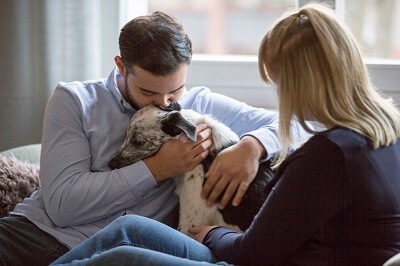 The simple act of petting an animal can release a potent cocktail of relaxing hormones. It may also lower blood pressure and improve physical health. Inspired by emerging research pointing to the many benefits of time with animals, many therapists are interested in incorporating animals into their therapy practice.
The simple act of petting an animal can release a potent cocktail of relaxing hormones. It may also lower blood pressure and improve physical health. Inspired by emerging research pointing to the many benefits of time with animals, many therapists are interested in incorporating animals into their therapy practice.
A therapy animal is distinct from a service animal, which performs specific tasks for a person with a disability. It is also not the same as an emotional support animal, which provides companionship and support to a person with mental or physical health issues. Therapy animals undergo training to ensure they can safely and positively interact with people. They may also have additional training, depending on the purpose for which the therapist uses them.
These animals can be a catalyst for therapeutic breakthroughs. They may ease the minds of anxious children and adults and serve as an additional tool for connection in therapy. Therapy animals also present a number of liabilities and risks, so therapists who want to use therapy animals for anxiety or other mental health conditions should weigh the benefits and risks.
Considerations for Animal-Assisted Therapy
Animal-assisted therapy offers numerous benefits for all age groups. Research suggests that spending time with animals may:
- Lower anxiety
- Decrease blood pressure
- Improve pain management
- Assist people with dementia in recalling memories
- Slow breathing
Animals can be especially helpful in autism therapy. Some autistic children feel more comfortable with animals than with people. This can help break the ice in therapy and establish common ground. Animal lovers may feel more comfortable talking about their emotions and experiences when an animal is present. Petting an animal while discussing traumatic memories may even help those memories feel less painful.
Animal-assisted therapy is not for everyone. Fear of animals, especially dogs, is common. Some people may even enter therapy because of these fears. Gradual and consensual exposure to an animal may help. But immediate, prolonged, or unwanted contact with animals will not correct the fear, so having an animal constantly present may undermine therapy in those cases.
Therapists considering animal therapy should also decide how they will manage clients with allergies. An effective strategy for removing both the animal and any allergens they create is key to client comfort.
Some people simply do not like animals and may be uncomfortable if an animal is present during therapy. Therapists who love animals may struggle to understand this position. Because a therapist’s role is to accept a client without judgment and to take a client’s needs seriously, therapists must not force animals on people who are uncomfortable with them. This may require a therapist to have a safe, secure place to put an animal during therapy with certain clients.
Therapy Animal Certification and Education Requirements
There is no consistent or uniform standard across the nation for animal-assisted therapy. Despite this, therapists should pursue some form of certification for the animal. Education on animals in therapy can also help the therapist become more effective.
The American Kennel Club’s Canine Good Citizen certification is a good basic requirement for animals in therapy. CGC recipients are not aggressive, capable of following basic commands, and can appropriately interact with strangers. Dogs who fail this test typically exhibit behaviors that can present problems in therapy.
A number of other organizations offer training and certification for therapy animals and their handlers. The Alliance of Therapy Dogs, for example, offers training, testing, and ongoing education. Local animal advocacy organizations may also offer behavior classes and various certifications.
Animals in Therapy: Choosing the Right Therapy Animal
Therapists use a wide range of animals in therapy. Virtually any animal’s presence can be therapeutic. Some animals, however, may not be a good fit. They include:
- Animals that are difficult or impossible to move when a phobic client is present. A large tortoise might be friendly and produce no allergens, but it could be too heavy to move to another room.
- Animals that are distracting. This includes animals who make a lot of noise, especially dogs that bark when they want attention.
- Animals that may stoke fear in many clients. Large snakes or lizards can be scary even to people who otherwise like animals.
- Unhealthy or sick animals. They may scare children, while adults may feel anxious or sad about the animal’s condition.
 When weighing animal therapy options, consider the goal of therapy, as well as how much you want to involve animals in therapy. A fish tank can feel serene and relaxing, and a cute small animal such as a gerbil may appeal to young children. Cats can be unobtrusive therapy animals who sit calmly in a client’s lap and who do not intrude on the therapy session or make noise when left in another room.
When weighing animal therapy options, consider the goal of therapy, as well as how much you want to involve animals in therapy. A fish tank can feel serene and relaxing, and a cute small animal such as a gerbil may appeal to young children. Cats can be unobtrusive therapy animals who sit calmly in a client’s lap and who do not intrude on the therapy session or make noise when left in another room.
Therapists who want animals to actively engage in the therapeutic process often choose dogs. This is because dogs are friendly and affectionate, tend to like most people, and are often good at playing with children.
Not all animals are a good fit for animal therapy. While you might love your family dog, merely being friendly or likable is insufficient for a therapy animal. Some qualities of dogs who are good candidates include:
- Well-behaved and easy to control. Dogs who are very hyper, who jump on furniture, or who do not stop interacting when asked can overwhelm clients.
- Quiet. Dogs who bark, whine, excessively pant, or who make other loud noises can be distracting.
- Well-groomed. A dog who smells, who sheds a lot, or who looks unkempt may be unappealing to clients.
- Totally non-aggressive. A dog who is friendly to people it knows or likes is not enough. The dog must be capable of being friendly to everyone and must have never shown even mild signs of aggression. Snarling, growling, snapping, aggressive barking, and other aggressive behaviors should exclude a dog from consideration. ‘
- Comfortable with a wide variety of people. An animal who is fearful of people who behave unusually or who does not like children is not a good choice.
Choosing the Right Population for Animal-Assisted Therapy
Animal-assisted therapy works best when clients like and enjoy the presence of animals. Clients who dislike animals or who reluctantly agree to the presence of an animal may not benefit from animal-assisted therapy. An animal who makes a client feel afraid can even be harmful. Likewise, if a client feels that a therapist is angry with them for not allowing an animal in therapy, this can disrupt the therapeutic alliance. Clients must not feel pressured into animal-assisted therapy and must feel that the animal is present for their benefit, not the therapist’s.
Exposure therapy can help clients overcome their fear of animals, but this exposure must be controlled. Therapists who plan to use animal-assisted therapy to help clients with animal phobias must have training and expertise in exposure therapy. Simply having an animal present for therapy sessions is rarely enough and may make the phobia worse.
Some populations in which animal-assisted therapy has proven especially helpful include:
- Autistic individuals
- People with dementia and memory impairments
- People with chronic pain
- People with chronic or terminal illnesses, such as cancer and heart disease
- People with developmental delays
Legal Aspects of Therapy Animals
The primary legal risk of animal-assisted therapy is that the therapist could be sued if an animal injures a client. In rare cases, such as if a therapist knows an animal is dangerous, the therapist could even face criminal prosecution. If an animal bites someone, animal control may confiscate the animal or even euthanize it. State and local laws vary, so become familiar with the rules governing your area.
Just as every human is capable of behaving inappropriately, so too is every animal. Because animals cannot express themselves in words, they may express fear or frustration with aggression. Therapists should not assume that their therapy animal cannot or will not bite. Instead, they should take proactive measures to protect clients and the animal. Never use an animal with any history of aggression in therapy. If an animal shows signs of fear, remove them immediately. Do not allow children to taunt animals.
Liability insurance can help protect a therapist from lawsuits. Your liability carrier will defend you if you are sued and pay the judgment—up to the policy limits—if you lose. Talk to your insurance carrier about insurance for animal-assisted therapy. In some cases, working with a certified animal may help lower insurance premiums or reduce your liability if you are sued.
Some other legal issues to consider include:
- The provisions of your lease, if you lease your office space. Some landlords forbid animals or require a substantial pet deposit.
- Local laws governing animal health care. You might be required to get an annual rabies vaccination or to register the animal.
- Animal safety and cruelty laws. You must be able to keep your pet safe and protect them from abuse. Allowing clients to mistreat the animal is almost always illegal.
- Local licensing and certification rules. Some areas require that therapy animals be registered with the county or city or that they receive specific certifications.
Animal-assisted therapy offers many benefits when therapists use it with the right people. As with any expansion of your practice, it’s important to know what you’re getting into and to plan for every contingency. GoodTherapy helps therapists better manage their practice. Membership opens access to our directory, practice management tips, and a wide variety of continuing education courses, including classes on using animals in therapy.
References:
- About the Alliance of Therapy Dogs. (n. d.). Retrieved from https://www.therapydogs.com/alliance-therapy-dogs
- Allen, K. & Colbert, L. (n. d.). Ethical and safety considerations for use of animals in a therapeutic setting. Retrieved from https://societyforpsychotherapy.org/ethical-safety-considerations-use-animals-therapeutic-setting
- Animal-assisted therapy research findings. (n. d.). UCLA Health. Retrieved from https://www.uclahealth.org/pac/animal-assisted-therapy
- Canine Good Citizen. (n. d.). American Kennel Club. Retrieved from https://www.akc.org/products-services/training-programs/canine-good-citizen
- What is animal assisted therapy? (n. d.). Retrieved from https://www.crchealth.com/types-of-therapy/what-is-animal-assisted-therapy


.png)